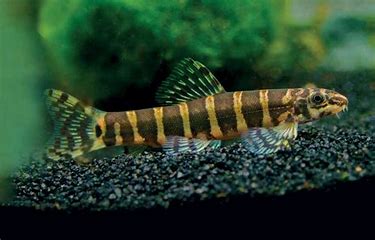SERPENT LOACH (SERPENTICOBITIS OCTOZONA)
Full Description
Serpent Loaches (Serpentico-bitis octozona) are fascinating, beautiful, and relatively rare fish, native to Southeast Asia. Known for their striking appearance with long, slender bodies and snake-like movement, they make a unique addition to any aquarium. Here’s a guide to their care:
1. Tank Setup
-
Tank Size: Serpent Loaches can grow up to 6-8 inches (15-20 cm), so they need a tank that’s at least 30 gallons (113 liters) or more to provide enough swimming space. If you’re planning to keep a group, you’ll need a larger tank.
-
Substrate: They prefer a fine, soft substrate like sand or smooth gravel since they spend a lot of time burrowing in the substrate. Avoid sharp rocks or rough gravel that could injure them.
-
Aquascaping: Plant the tank well, as they enjoy hiding in plants, caves, and driftwood. A natural, soft environment mimics their natural habitat.
-
Water Parameters:
-
Temperature: 75–80°F (24–27°C)
-
pH: 6.5–7.5
-
Hardness: 4–10 dGH
-
Water Quality: They are sensitive to poor water quality, so maintain regular water changes (about 25-30% weekly). A good filtration system is essential.
-
2. Feeding
-
Diet: Serpent Loaches are omnivores but lean toward a carnivorous diet. They will eat a variety of foods, including:
-
Live or frozen foods: Worms, shrimp, bloodworms, and brine shrimp.
-
Pellets and flakes: High-quality sinking pellets designed for bottom-dwellers will be appreciated, but they may also eat algae wafers.
-
-
Feeding Frequency: Feed them small amounts 1-2 times a day. Remove any uneaten food to avoid polluting the water.
3. Tankmates
-
Compatibility: They are generally peaceful but may be somewhat territorial, especially if there are other bottom dwellers. Good tankmates include:
-
Peaceful community fish like tetras, rasboras, and danios.
-
Other calm loaches, such as Clown Loaches or Skunk Loaches.
-
Avoid fin-nipping species and overly aggressive fish.
-
4. Behavior
-
Serpent Loaches are nocturnal, which means they are most active at night, often coming out of their hiding spots to scavenge for food or explore the tank.
-
They have an interesting, “serpentine” swimming style, often slithering around the substrate or hiding in crevices.
-
They do best in groups, as they are social creatures and feel safer in the presence of others of their own species. Keeping at least 3-4 together is ideal.
5. Health Considerations
-
Common Diseases: Like many tropical fish, they are susceptible to parasites like Ich, velvet, and skin fungus if water conditions are poor or stressful. Keeping the water clean and the tank stress-free helps prevent outbreaks.
-
Stress Indicators: If your serpent loach is hiding excessively, not eating, or showing abnormal swimming behavior, these could be signs of stress or illness.
6. Breeding
-
Breeding in captivity is not well-documented, but it’s believed that they require specific environmental triggers (like changes in water temperature or the rainy season) to spawn. As such, breeding Serpent Loaches in home aquariums is considered rare and challenging.
12 in stock

